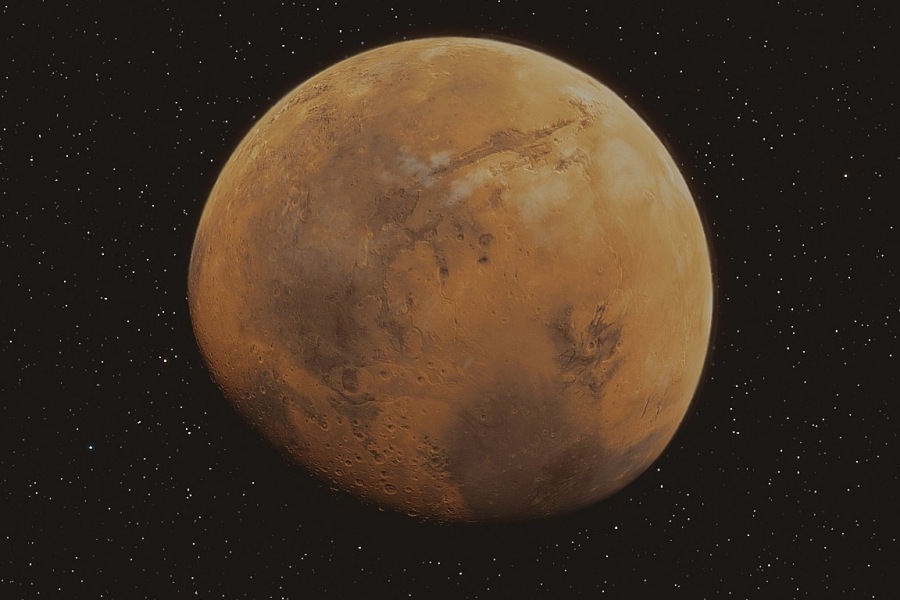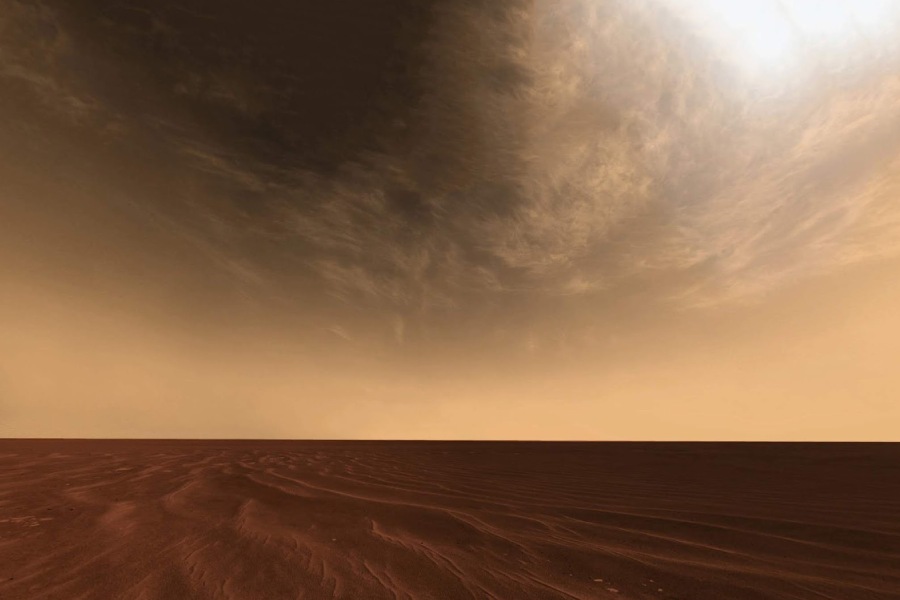When you explore the night sky with a telescope, you can often see Mars as a bright red dot. But what does the surface of the red planet actually look like? Does Mars have a cloudy atmosphere like Earth, or is its sky clear and empty?
Mars‘ atmosphere and weather patterns have long fascinated astronomers. Understanding the climate on Mars can provide insights into the planet’s potential to host life. Clues about Martian clouds also allow comparisons to Earth’s own atmospheric evolution over geological time.
In this article, we will explore the question – does Mars have clouds? We’ll analyze evidence from past Mars missions and the latest atmospheric studies.
While details remain murky, emerging research seems promising in decoding the truth about Mars. We’ll review the implications of possible Martian clouds for the planet’s climate, habitability, and similarities with Earth.
Does Mars Have Clouds?
Does Mars have clouds? Yes, Mars has clouds made of water ice that float in its thin atmosphere. These Martian clouds often appear as wispy, thin formations, not the fluffy white clouds found on Earth.
Despite their ethereal appearance, these clouds play a role in Martian weather and climate, similar to the function of clouds on Earth. So, while clouds on Mars may not resemble those of our blue planet, this dynamic red planet still has its own versions drifting across the Martian sky.

Types of Clouds and Cloud Formation
Cloud classification on Earth
On Earth, clouds are classified based on their appearance and the altitude they form in the atmosphere. Low altitude tropospheric clouds like stratus and cumulus tend to be thick, dense, and gray in color, blocking sunlight from reaching the surface.
In contrast, high altitude cirrus clouds are thin, wispy, and have a featherlike appearance. Between these extremes are several subtypes like stratocumulus, nimbostratus, altostratus, etc.
Understanding the properties and formation mechanisms of different terrestrial cloud types provides an important reference point. It also offers a framework for analyzing the types of clouds that may form on Mars, given its different atmospheric conditions.
Factors for Earthly cloud formation
On Earth, clouds form when invisible water vapor suspended in the air is cooled below its dew point temperature, the level at which condensation occurs. The exact dew point depends on both the temperature profile and pressure conditions in the atmosphere. A number of mechanisms can trigger air parcels to cool below their dew point, resulting in cloud formation.
There are several mechanisms that lead to terrestrial cloud formation. These include uplift of air over mountains and the collision of different temperature and moisture air masses at frontal boundaries. Another mechanism is the convection of air parcels from solar heating of the surface.
The interplay between moisture availability, temperatures, pressures, and dynamic triggers gives rise to the wide range of cloud types exhibited in Earth’s atmosphere.
Potential Martian cloud types
In contrast to Earth, Mars possesses an extremely thin atmosphere composed primarily of carbon dioxide rather than nitrogen and oxygen. However, spectroscopic measurements show Mars’ atmosphere does contain trace amounts of water vapor.
Climate modeling studies suggest wispy, high-altitude clouds of water-ice crystals could potentially form on Mars, where temperatures are cold enough.
However, thicker, more substantial clouds at lower altitudes would require higher concentrations of water vapor, which may be too scarce on Mars for abundant cloud formation.
Any clouds emerging on Mars would likely exhibit very different compositions, altitude distribution, and visual appearance compared to typical clouds found on Earth due to the vastly different pressures, temperatures, moisture levels, and atmospheric dynamics.
Types of Clouds on Mars
Studies of the Martian atmosphere have revealed a range of cloud types existing under different conditions. However, clouds on Mars form through markedly different mechanisms than on Earth due to the planet’s extremely thin atmosphere. This is about 1% of the density of Earth’s atmosphere.
As a result, Martian clouds tend to be limited to very high altitudes, on the order of 18 miles and above. They tend to be thin, wispy, and streaky in nature.
Noctilucent clouds in the polar regions
One major type is noctilucent clouds found in the polar regions during summer. These clouds occur at altitudes around 49 miles, where atmospheric temperatures allow water vapor to freeze into ice crystals. The ice crystals then reflect sunlight, causing the clouds to have a distinctive bluish or whitish tint.
They bear some resemblance to high-altitude cirrus clouds found on Earth but exist due to different physics and chemistry in the upper Martian atmosphere. Noctilucent clouds indicate water transport in the global circulation.
Iridescent clouds in the middle atmosphere
Another cloud type consists of colorful, iridescent clouds occasionally seen around 18-37 miles in altitude at middle latitudes. These stratified clouds are composed of water-ice crystals, typically a few micrometers in size.
Their optical properties create colorful displays as light diffracts through the regular crystal structure. They are similar in nature to nacreous clouds that form in Earth’s stratosphere but again arise due to different mechanisms in the considerably thinner Martian atmosphere.
High-altitude clouds in the twilight zone
At the highest altitudes of 37-49 miles lies Mars’ twilight zone. Here, thin cirrus-type clouds can form composed of both water-ice and frozen carbon dioxide. Being high up, these clouds tend to be quite faint and streaky.
They are similar visually to terrestrial cirrostratus clouds, but exist due to different environmental factors in Mars’ high atmosphere transitioning between the lower and upper layers. The twilight zone includes complex dynamics that impact the planet’s cloud formation and atmospheric circulation.

Components of Martian Clouds
The composition of Martian clouds is directly tied to the planet’s thin, frigid atmosphere and lack of liquid water. Primary constituents include water ice crystals and dry ice, though dust, methane, and other volatiles may also be incorporated to form mixed-composition clouds.
The prevalence and variability of cloud components provide crucial insights into atmospheric circulation, chemistry, surface-atmosphere interactions, and potential biosignatures.
Temperature and humidity levels
Surface temperatures on Mars average around -76°F and rarely exceed 68°F, even during summer. This extreme cold allows clouds to form through depositional ice nucleation at high altitudes above 18 miles, where the atmosphere is cold enough for water vapor to freeze.
Lower in the atmosphere, the air is extremely desiccated, with less than 1% relative humidity near the surface. This prohibits substantial cloud formation without anomalous localized humidity.
Water ice crystals
Many Martian clouds contain tiny hexagonal ice crystal structures ranging from a few micrometers to around 100 microns in size. Their precise microphysical morphology and development are dictated by the atmospheric temperatures, pressures, dynamics, and availability of water vapor.
Cirrus-like filaments, diffusional ice hazes, and crystal settling patterns all provide insights into atmospheric circulation and the Martian water cycle.
Incorporation of dry ice
In addition to water ice, Martian clouds are thought to contain significant amounts of frozen carbon dioxide or “dry ice”. This is because CO2 comprises over 95% of the planet’s atmosphere.
The iIncorporation of dry ice reveals complex mixing between atmospheric layers and depends on factors like latitude, topography, time of day, and seasonality. Dry ice concentrations in clouds influence opacity, coloration, and precipitative dynamics.
Dust nuclei
Some Martian clouds incorporate dust particles lifted from the planet’s surface as cloud condensation nuclei. The deposition of atmospheric ice directly onto these dust grains leads to mixed-phase dust-ice clouds.
It points to important interactions between surface and atmospheric processes on Mars, as dust is exchanged between the ground and air. Tracking the motion and properties of dust-laden clouds assists in weather forecasting and understanding global transport patterns.
Dust provides surfaces for heterogeneous ice nucleation at lower supersaturations and warmer temperatures than required for homogenous ice nucleation. This promotes cloud formation.
Dust nuclei likely serve as precipitation formation sites, influencing the dynamics, location, and properties of icy precipitation on Mars. The number, density, and precise composition of dust grains affect cloud properties like opacity, reflectivity, and precipitation rates.
Other volatiles
Trace amounts of methane could be incorporated, which would provide clues about methane sources from the subsurface and local concentration anomalies. Sulfur dioxide, originating from volcanism or atmospheric photochemistry, may also be scavenged into cloud particles, contributing to aerosol chemistry.
Water vapor is likely supersaturated within clouds, serving as a reservoir upon condensation into ice. Salts like magnesium and sodium perchlorate have also been detected and can influence cloud chemistry.
The distributions of these minor volatile components give insights into subsurface outgassing sources, atmospheric reactivity, global circulation patterns, and localized concentration mechanisms.
Conclusion
Does Mars have clouds? Through looking at evidence from orbital images and rover observations, we learned that Mars does indeed have clouds. However, they are thinner and more wispy than clouds on Earth due to the Red Planet’s thin atmosphere.
Martian clouds are made primarily of water, ice, carbon dioxide, and dust particles. Understanding the behavior of Martian clouds gives scientists insights into the planet’s weather patterns and climate.
We hope this article has helped give you a better understanding of the interesting meteorological phenomena that exist on our planetary neighbor, Mars. Though distant, studying Mars continues to teach us more about planetary atmospheres and climates throughout our Solar System and beyond.
